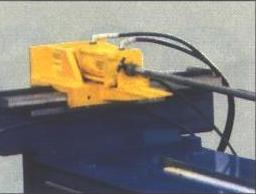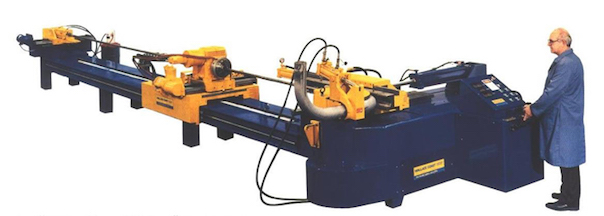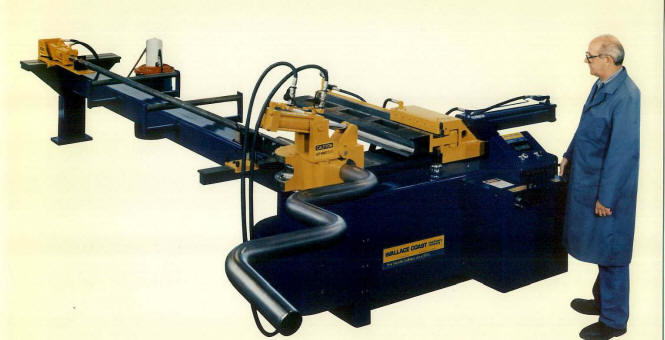
Single Angle Axis Benders
T-65 Series Brochure
BENDERS FOR TODAY
Jesse Co. Single Axis benders are operator controlled (non-CNC) 1-axis benders - hydraulically powered. With the proper bending tools, they have the power, accuracy, and rigidity to produce wrinkle free bends, with a minimum of ovality and wall thinning, in pipe and tubing of various metals and alloys.
Jesse Co. benders are engineered and built to state of the art machine tool standards, including JIC. Their capacities are stated in terms of Sch. 80 pipe - not a thin-wall tube whose section modules may only be half as great. Standard capacities are: 3", 4", 6", 8" IPS (60.3, 88.9, 114.3, 168.2, 219mm) - and larger.
AN IMPROVED DESIGN
Benders are more rugged, and versatile than traditional "swing arm" benders. Because no swing arm or pressure die mechanism hangs below the plane of the bend die, the main frame of a 1000 series bender is positioned where it ought to be, directly beneath and supporting the pressure die slide (Fig. 4). Thus, all the bending forces - exerted by the spindle and resisted by the pressure die - are directly "resolved" within a single, compact heavy duty, tubular beam. Jesse Co. 1000 series benders also have the largest spindle and bearing diameters, the greatest spread between bearings, and the smallest distance from bend die to upper spindle bearing - all to insure the greatest possible rigidity.
The main components included in the standard Jesse Co. Single Axis bender are the Main Frame, the Mandrel Table, the Mandrel Extractor, the Mandrel Rod, the Hydraulic Control System and the Overhead Clamp.
INTEGRAL ("OVERHEAD") CLAMP
By mounting the hydraulic clamping mechanism on the rotating bend die itself, Jesse Co. has eliminated the conventional swing-arm (Fig. 4). There are many advantages to this system.
Built-in clamp alignment in the matching mounting surfaces of the clamp mechanism and bend die assure that no vertical or horizontal clamp set-up adjustment is required. Therefore tool changing is faster and easier.
The clamp opens upwards, eliminating interference with the forward feed of the bent workpiece. Potential interference between the clamp and the advancing workpiece is a major shortcoming of traditional swing arm benders. This problem is usually overcome by the use of a cam or linage type drop-down clamping mechanism or by a separately pivoted coaxial swing arm and main shaft. Both are complex, compromise "fixes". Jesse Co.'s overhead clamp system eliminates this problem.
Clamping forces are self contained - not carried through the die mount, the spindle, or any other part of the machine. Thus, there is never any bend-die tilt caused by clamping forces.
No overhead tie bar is required with an overhead clamp, because there is no clamp-pressure induced bend die tilt - even when bending the heaviest or most "critical" workpieces.
Tooling remains properly aligned because the bend die rotates in a level plane throughout the bend.
Machine and tooling maintenance are reduced. There are no swing arm slides or toggle linkages to shear or break, and less stress and wear on the tooling.
Overhead clamping is safer. The dangerous "pinch point" between the swing arm and pressure die arm is gone.
The operator has direct control of the clamping forces. They are easily read on a pressure gauge and easily set with a relief valve, assuring consistent, accurate set-ups. (Toggle type clamp mechanisms generate unreadable, and necessarily excessive, forces at their top-dead-center, pre-lock up position.)
 Fig. 3 The mandrel extractor unit incorporates both centerline radius set-up adjustment and lead screw mandrel tangent position setup adjustment - a major improvement over the old method of screwing the mandrel in and out on the mandrel rod. Motorized adjustment of the centerline radius is optional.
Fig. 3 The mandrel extractor unit incorporates both centerline radius set-up adjustment and lead screw mandrel tangent position setup adjustment - a major improvement over the old method of screwing the mandrel in and out on the mandrel rod. Motorized adjustment of the centerline radius is optional.
MANDREL SYSTEM
The mandrel beam incorporates the mandrel extractor cylinder and pipe supports.
The basic bender is complemented by the mandrel beam unit, without design compromises to either. The standard 20' (6.1m) load length is also not restricted by the bender's main beam length and does not require an extended frame or other modifications.
Powered centerline radius adjustment of the mandrel unit during set-up is optional on 1000 series benders.
20' (6.1m) over-mandrel load length assure being able to load full pipe lengths in one continuous motion with no hitch feeding. Greater load lengths are available.
Mandrel tangent position set up adjustment is accomplished by a lead screw on the mandrel extractor cylinder - an improvement over the traditional method of screwing the mandrel in and out on the end of the mandrel rod.

FIG. 4 The "overhead clamp" on top of the radius die opens out of the path of the advancing workpiece. This machine is a booster bender with a second clamp - the booster clamp - on the rear of the pressure die. Booster bending permits right radius bends with a minimum of wall thinning.
PRESSURE DIE SYSTEM The pressure die mounts on a massive master-bar carrier riding on oversized ways which are attached directly to the main beam - not to a cantilevered arm.
The direct acting pressure die cylinder is mounted in the centerline plane of the tube to directly resist the bending forces.
The pressure die carrier slide and the masterbar are long enough to permit making 3xD 90º bends at the machine's rated capacity.(Greater lengths are available).
OPTIONAL PRESSURE DIE ASSIST (OR BOOSTER) FOR REDUCED WALL THINNING
Unlike other benders, the pressure die assist and booster systems on Jesse Co. 1000-PC series benders are not "add-ons". The pressure die assist/booster cylinder is integrated into the pressure die carrier head - parallel to the centerline of the workpiece, where it ought to be, so that it won't impose any asymmetrical loads. The massive pressure die carrier ways on Jesse Co. 1000 series benders can accommodate the loads imposed by a booster system. Both the lateral pressure die assist/boost pressure are adjustable from the control console through reference gauges.
Pressure die assist bending (optional) involves the use of controlled push-force applied to the pressure die. This reduces tool drag and helps control workpiece thinning. However, since the pressure die is not clamped to the workpiece, total assist force is limited by the co-efficient of friction between the pressure die and the tube. Pressure die assist bending is not the same as booster bender.
Booster bending (optional) involves a continuous push-force applied directly to the workpiece through a booster clamp. To achieve maximum booster effect, the booster cylinder and its mounting system must be able to exert a sufficient load to bring the workpiece close to compressive yield. With the Jesse Co. boost system, the booster clamp is mounted directly on the rear of the pressure die, which then provides continuous column strength reinforcement of the workpiece under high booster loads (Fig. 4). A sequence of four pre-selected boost pressures are automatically applied as designated degree-of-bend points are reached.
"Shaped groove" no-mandrel bending combines special tools with pressure die assist (or optional boost for shorter radius bends) permitting non-mandrel bending of a broad range of pipe and heavier walled tube while minimizing wall thinning and ovality.
OPERATOR CONTROLS
All functions are controlled by handlever valves, combined with digital position displays for all three axes.
(Fig. 4) The bend axis has a digital degree-of-bend controller, with up to 16 (depending on model) programmable pre-sets, controlling both a slow down valve and a stop valve for maximum bend accuracy. The operator simply pulls the "BEND" lever until the spindle automatically stops at the desired degree-of-bend.
Hand lever controls are safer than push button solenoid valves because the operator's hand must always be on the control lever. The operator is safely at the control station during the bend cycle - and the machine stops the moment the lever is released.
Hand Levers allow greater operator control. They can be "cracked" open for low speed or small incremental moves - unlike push button solenoid valves, which are either "ON" or "OFF".
Control lever operation of a 1000 bender is ergonomically designed. The direction of lever movement coincides with the resultant machine movement and/or is simply logical. The levers are sequenced, in functional order, from the operator's left to right.
The bend cycle controls are:
- CLAMP: pull = clamp / push = open.
- PRESSURE DIE: pull = close / push = open.
- MANDREL: pull = forward / push = back.
- BEND: pull = bend / push = return. (Also returns masterbar).
- MASTERBAR: pull = advance / push = return.
(Only used for set-up. During bending the masterbar, which carries the pressure die, advances with the tube. When the bend die is returned, the masterbar automatically returns first.) Because the masterbar control lever is not normally used by the operator, this is called a "four-Lever" Control System.
Pressure gages on the control panel show pressure readings for the Clamp, Pressure Die, and Pressure Die Assist/Boost Cylinders.
Electronic and hydraulic control components on the machine either are located away from points where they might be struck by workpieces during loading and unloading, or are provided with protective guarding.
MACHINE TOLERANCES
The accuracy of the workpiece produced by a bender can be no better than the machine.
Jesse Co. benders are accurate:
- C-Axis/Degree-of-Bend (Bend Spindle) to ±0.2º
OTHER OPTIONS AVAILABLE
- Pressure Die Assist
- A mandrel lubricator system which pumps heavy lubricant - Jesse Co. BEND EZ - through the hollow mandrel rod and out through holes in the side of the mandrel.
- Powered cross slide, push button operated, in lieu of hand wheel.
- A machine lubricator system which automatically lubricates the drive chain.
| Specifications | T-65 | 1003 | 1004 | 1006 | 1008 | 1010 |
| Maximum Pipe Size | 2/80 | 3/80 | 4/80 | 6/80 | 8/80 | 10/80 |
| Maximum OD | 3.0" | 4.0" | 5.0" | 8.0" | 10.0" | 12.0" |
| Minimum OD (suggested) | 0.84" | 0.84" | 1.030" | 2.375" | 3.500" | 4.500" |
| Wall Thickness @ Max OD | 11 ga Max / 14 ga Min |
.1875" | .1875" | .250" | .250" | .250" |
| Maximum CLR | 7.5" | 15" | 12" | 18" | 24" | 30" |
| Maximum Spindle Rotation | 193º | 193º | 193º | 193º | 193º | 193º |
| Maximum Length over mandrel | 12'/20' | 20' | 20' | 20' | 20' | 20' |
| Working Height | 42" | 42" | 42" | 42" | 50" | 60" |
| Tooling Centerline Height | 1.625" | 2.500" | 3.000" | 4.375" | 6.000" | 7.000" |
| Mandrel Stroke | 7" (Opt.) | 7" | 10" | 14" | 18" | 18" |
| Follower Stroke | N.A. | 31" | 42" | 61" | 44" | 55" |
| Pressure Die Stroke | 3-3/8" | 5" | 6" | 8" | 10" | 12" |
| Hydraulic Tank Capacity | 2 gal. | 10 gal. | 20 gal. | 40 gal. | 80 gal. | 150 gal. |
| Hydraulic System Pressure | 3000 psi | 3000 psi | 3000 psi | 3000 psi | 3000 psi | 3000 psi |
| Length Rearwards | 13'-6" | 23' | 23' | 24' | 25' | 26' |
| Length Forwards | 8" | 10" | 12" | 16" | 24" | 32" |
| Mandrel Rod OD | 1" | 1.66" | 1.90" | 2" | 2" | 3" |
| Mandrel Thread | 1-8 UNC | 1.25-12 | 1.75-10 | 2-12 | 2-12 | 3-12 |
| Standard Overhead Clamp | T-65 | #2 | #3 | #4 | #5 | #6 |
| Overall Width | 51" | 78" | 108" | 10' | 19' | 21' |
| Height | 50" | 54" | 56" | 60" | 78" | 89" |
| Weight (lbs.) | 1900 | 4000 | 9200 | 15,400 | 20,000 | 27,000 |
| Speed Fwd/Rev (rpm) | 1 / 5 | 1.3 / 3.2 | 1.0 / 3.4 | .60 / 3.7 | .60 / 2.2 | .50 / 2.4 |
| Bend Angle Presets | 2 | 2 | 2 | 16 | 16 | 16 |
| Electrical Supply | 220V 1Ph. | 480V 3Ph. | 480V 3Ph. | 480V 3Ph. | 480V 3Ph. | 480V 3Ph. |

